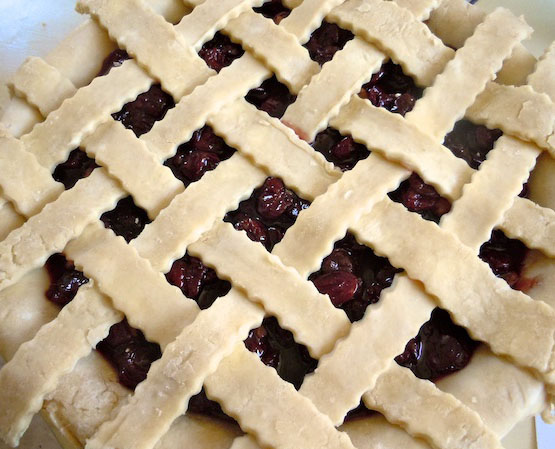 Lest you all begin to sniff that writing about a cherry pie in August (that was actually made in late July) is a tad off-season (and I can hear you sniffing, so don’t pretend you are not), let me tell you a little of how the Siouan peoples described a couple of their summer months in lunar terms – July is known as the “Moon of Red Cherriesâ€; August, “Moon When the Cherries Turn Black.†As my pie was created in the midst of these two moons, I’m perfectly timely. And in the space between these cherry moons I decided to meld two species of this summer fruit — I made the pie of dried (blackened) sour cherries reconstituted with sweet cherry juice.
Lest you all begin to sniff that writing about a cherry pie in August (that was actually made in late July) is a tad off-season (and I can hear you sniffing, so don’t pretend you are not), let me tell you a little of how the Siouan peoples described a couple of their summer months in lunar terms – July is known as the “Moon of Red Cherriesâ€; August, “Moon When the Cherries Turn Black.†As my pie was created in the midst of these two moons, I’m perfectly timely. And in the space between these cherry moons I decided to meld two species of this summer fruit — I made the pie of dried (blackened) sour cherries reconstituted with sweet cherry juice.
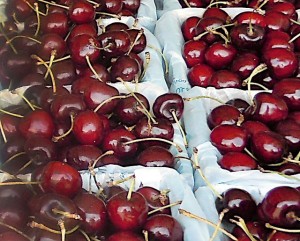 For the sweet cherries (normally peaking in June and July) are still plentiful in California. On a recent trip to the Salinas Valley, I noticed the cherry stands dotted the roadside, their sweet fruit still in full season. Dried cherries are readily available all year. I took a liking to the notion of creating a pie from dried fruit. I have used dried fruits in a number of baked goods and, having heard of a creature known as raisin pie, I thought dried cherry pie had to be as good, if not better.
For the sweet cherries (normally peaking in June and July) are still plentiful in California. On a recent trip to the Salinas Valley, I noticed the cherry stands dotted the roadside, their sweet fruit still in full season. Dried cherries are readily available all year. I took a liking to the notion of creating a pie from dried fruit. I have used dried fruits in a number of baked goods and, having heard of a creature known as raisin pie, I thought dried cherry pie had to be as good, if not better.
As I was reading about raisin pie in my “Betty Crocker Picture Cook Book†(1950), I discovered that raisin pie was once called “funeral pie†because it was often served at such occasions. Why this pie in particular? Though the book did not explain, it crossed my mind (as AWS is often at the mercy of both her whimsy and her dark side, usually at the same time) that raisins represented something “passed†(grapes). A little creepy looking at it that way, I know. The beauty of reconstituting fruit is that you can bring it back to life (the dead grapes live on!), even though it comes back not quite as it was, but still good and thankfully not as dangerous as those animals (including humans) brought back from the “bone yard†in Stephen King’s “Pet Sematary†(just a little wink to my kin out there – ha).
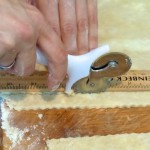
For my pie filling, I found dried cherries at both a local fruit stand and Trader Joe’s. The Trader Joe’s brand states that they are specifically Montmorency – a top pie cherry. I grew up with Montmorency cherries. We’d pick them each June until our arms were sticky with sweat and cherry juice and achy from the reaching. But, boy, are they great cherries – firm, juicy and perfectly tart. The dried version is slightly sweeter, but the echo of tart remains. And the most beautiful thing of all – someone else has taken out the pits. I remember the cherry pitter my mother ran the Montmorency cherries through at home. It was a laborious process that left the cherries more pulplike than whole. And pitting them one by one – if you did not have the patience and stamina – could drive you mad.
I found sweet black cherry juice at the local supermarket. I thought this might lend a nice sweet note as the plumping catalyst for the dried cherries. They swelled up nicely in the heated juice. The filling was thickened with a little flour and complimented with the tang of citrus and a little crunch from some chopped walnuts.
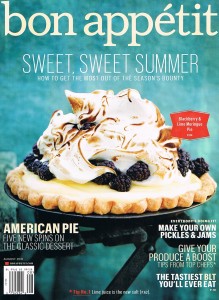 In choosing a crust recipe, I was drawn to a rather comely cover of the August issue of Bon Appetit magazine, an issue that featured a slew of pie recipes and showed how to fashion a lattice-top crust, which I wanted for this pie in particular. Their Master Pie Crust recipe (featured below) is truly butter-heavy, but very easy to handle. If one is to take the plunge and cut strips to be woven, a very user-friendly crust is ideal. The magazine (and website) feature a great how-to on forming a lattice crust. The instructions are truly helpful, and it is simpler than one would imagine. There is no need to blow one’s mind or storyboard a set of plans in order to weave a lattice crust – it is merely a process of folding back alternating strips on one half of the pie, layering in a strip crosswise, then folding back a second set of alternating strips, etc., until the pie-top weave is complete. Do this, my friends, and no matter how the damn pie tastes, it’ll look and feel as though you loomed a hallway runner.
In choosing a crust recipe, I was drawn to a rather comely cover of the August issue of Bon Appetit magazine, an issue that featured a slew of pie recipes and showed how to fashion a lattice-top crust, which I wanted for this pie in particular. Their Master Pie Crust recipe (featured below) is truly butter-heavy, but very easy to handle. If one is to take the plunge and cut strips to be woven, a very user-friendly crust is ideal. The magazine (and website) feature a great how-to on forming a lattice crust. The instructions are truly helpful, and it is simpler than one would imagine. There is no need to blow one’s mind or storyboard a set of plans in order to weave a lattice crust – it is merely a process of folding back alternating strips on one half of the pie, layering in a strip crosswise, then folding back a second set of alternating strips, etc., until the pie-top weave is complete. Do this, my friends, and no matter how the damn pie tastes, it’ll look and feel as though you loomed a hallway runner.
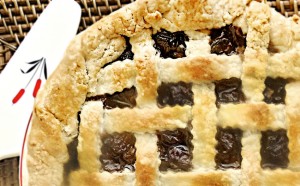 As it turns out, my pie actually did taste good. Using the dried cherries, plus the sweet cherry juice, it made for a dense and extremely rich pie, dark as a moonless night. A thin wedge will do you amply, as the pie is a considerably sweet experience. A dollop of vanilla ice cream is a nice accompaniment. Between the sweet filling, the tender, buttery crust and a glowing scoop of moon-white Haagen Dazs, this lunar cycle of pie-baking turned out just dreamy.
As it turns out, my pie actually did taste good. Using the dried cherries, plus the sweet cherry juice, it made for a dense and extremely rich pie, dark as a moonless night. A thin wedge will do you amply, as the pie is a considerably sweet experience. A dollop of vanilla ice cream is a nice accompaniment. Between the sweet filling, the tender, buttery crust and a glowing scoop of moon-white Haagen Dazs, this lunar cycle of pie-baking turned out just dreamy.
Moon of the Dried Cherries Pie
Makes 1 9-inch pie
2 cups dried sour cherries (recommended: Montmorency)
1 cup sweet cherry juice
1 cup water
2/3 cup sugar
Pinch of salt
3 tablespoons flour
½ cup chopped walnuts
1 tablespoon lemon zest
3 tablespoons lemon juice
½ teaspoon almond extract
Combine cherries, cherry juice and water in a saucepan on the stove. Bring to a boil over low heat. Combine sugar, salt and flour, add to cherry mixture and continue to cook, stirring constantly. Bring to a boil; cook one minute. Remove from heat and stir in walnuts, lemon zest, lemon juice and almond extract. Allow filling to cool completely before filling pie.
Preheat oven to 400 degrees. To make pie, roll out ½ Master Pie Crust (see below) and fit into a 9-inch pie plate. Roll out seond half of dough and cut into ¾-inch strips, using a knife or a pastry wheel. Lay strips across pie to form lattice top. Trim and crimp edges. Brush top of lattice and crimped edges with egg wash of one beaten egg and a tablespoon of water. A great slideshow of the lattice process is online here.
Place pie on a baking sheet and put in oven. Bake at 400 degrees for about 20 minutes; reduce heat to 350 and bake for about 20 to 30 minutes longer until crust is nicely browned and cherries are bubbling through the lattice top!
Master Pie Crust
From Bon Appetit Magazine
3 1/2 cups all purpose flour
1 cup (2 sticks) chilled unsalted butter, cut into 1/2″ cubes
1/4 cup vegetable shortening
1 tablespoon plus 1 tsp. sugar
1 tablespoon kosher salt
Process flour, butter, vegetable shortening, sugar, and salt in a food processor until butter resembles tiny pebbles, about 25 seconds. Transfer to a large bowl. Gradually add 3/4 cup ice water, using a fork to stir until dough is a mixture of clumpy wet pieces and sandier pieces, adding more water by tablespoonfuls if dry. Press plastic wrap over surface of dough. Chill in the bowl at least 1 hour or overnight.
For a single- or double-crust unbaked pie crust:
Divide dough in half. Flatten each half into a disk. On a lightly floured surface, roll out 1 disk into a 13″-14″ round. Roll over rolling pin and transfer to the pie dish. Pick up the edges and allow dough to slump inside the dish. Trim, leaving about 1″ overhang. (For single-crust pie, fold overhang under and crimp edges.) Chill at least 1 hour or overnight.
Blogger’s note: References to the cherry moons were taken from a wonderful book, “Black Elk Speaks: Being the Life Story of a Holy Man of the Oglala Sioux†(1932).